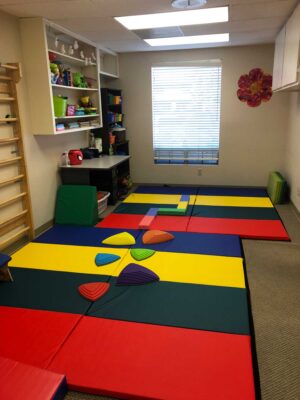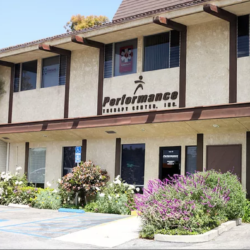The basics of pediatric physical therapy
- Physical therapy is often recommended for children and teens who have been injured or who have movement problems from an illness, disease or disability.
- Pediatric physical therapists have special training in working with the growing bodies of children.
- Individualized treatment plans incorporate exercise, purposeful play, education, activity modification and other techniques according to a child’s changing needs.
- Spine & Sport Physical Therapy works with infants, children, teens and their families to promote mobility and quality of life.
Move forward, faster, fearlessly
What is pediatric physical therapy?
Pediatric physical therapy helps children and teens maintain, gain or recover physical movement abilities that have been impaired by injury, disease, disability or illness.
Pediatric physical therapists have expertise in movement, motor development and body function of children, which can differ from the functions of adults. They are specialists in working with kids, young adults and their families, dedicating their careers to treating growing bodies.
Depending on the child’s health and needs, therapy may last anywhere from several weeks to years. Likewise, the goals of treatment vary but commonly include:
- Maintaining function and adapting to any loss of function.
- Improving mobility including range of motion, reflexes and balance.
- Increasing strength and tone.
- Reducing pain.
- Rehabilitating or recovering from injuries.
- Preventing disabilities or future injuries.
- Avoiding more extensive treatment such as surgery.
Pediatric physical therapy isn’t merely for older children or teens, it is design for children of all ages, from newborns to 18-year-olds. Physical therapy for babies and toddlers can help address mobility problems stemming from birth injuries, genetic defects and other factors that can affect very young children.
Depending on the reason for physical therapy, the therapist will work closely with a primary care doctor, surgeon, specialist, speech therapist or any other providers who make up the child’s care team.
What childhood conditions can benefit from physical therapy?
Any condition that causes a child to have difficulty with normal movement or development can be treated with pediatric physical therapy. One of the most common reasons to engage in physical therapy is due to an injury from sports or play, such as a concussion and broken or sprained bones. Children who are not meeting developmental milestones (i.e., sitting, standing, rolling over and walking) or have issues keeping up with their peers during play may also benefit from physical therapy.
Our therapists can also aid in managing symptoms or side effects from many conditions affecting children. This can include:
- Cerebral palsy.
- Concussions.*
*While Spine & Sport does treat concussions in school age children, younger children with a head injury are typically referred to a specialist’s care.
- Down syndrome.
- Developmental coordination disorders.
- Developmental delays.
- Head-shape flatness in infants: plagiocephaly, brachycephaly and scaphocephaly.
- Hypotonia (muscle weakness).
- Infant brachial plexus injury.
- Infant prematurity.
- Juvenile rheumatoid arthritis.
- Muscular dystrophy.
- Neurological conditions.
- Neuromuscular disorders.
- Orthopedic conditions.
- Osgood-Schlatter disease.
- Scoliosis.
- Slipped capital femoral epiphysis.
- Spina bifida.
- Spinal muscular atrophy.
- Toe walking.
- Torticollis.
What to expect with physical therapy for infants, children and teens
Physical therapy is one of the most important tools in addressing movement issues or pain from an injury, illness or disability. The exact nature of this treatment plan will vary, depending on a child’s unique situation.
Evaluation
During the initial visit, a therapist will evaluate a child’s overall health, discussing concerns and goals with the parents. Depending on the child’s age, medical history and concerns, the evaluation may also include testing of:
- Flexibility and strength.
- Gait (how a child walks and runs).
- Motor skills.
Our therapists will design a care plan that incorporates more specific exercises or activities depending on the child’s issues and needs. We may also conduct other tests to more objectively assess changes and the progression of a condition over time in order to predict when changes in care or mobility might be indicated.
Physical therapy sessions
 As the goal of therapy is to help a child move in a healthier way, treatment typically revolves around improving movement and strengthening skills needed for daily activities. This can be accomplished through guided activities, stretching, exercising, bracing and teaching adaptive techniques to perform daily activities.
As the goal of therapy is to help a child move in a healthier way, treatment typically revolves around improving movement and strengthening skills needed for daily activities. This can be accomplished through guided activities, stretching, exercising, bracing and teaching adaptive techniques to perform daily activities.
For younger children, therapy often harnesses “purposeful play” including the use of colorful balls, hoops, foam rollers, toys and other equipment. While it may look like fun and games, the movement required and equipment used during therapy are designed to help a child gain or regain gross motor skills (those requiring whole body movement), as well as manage pain and prevent falling.
If a child is diagnosed with a specific disorder, therapists will also provide education and therapeutic techniques to prevent or reduce some of the additional complications that might occur with the condition. These include developmental delays, poor strength and posture, and abnormal movement or walking patterns.
For example, physical therapy is commonly a part of a treatment plan for cerebral palsy (CP), a neurological condition affecting 3 out of 1,000 births in the United States. CP makes it hard for someone to control the body, and individuals often have trouble seeing, hearing, feeling touch and communicating.
In the example of CP, physical therapy will likely involve a therapist helping the child learn to work with his or her body, develop more control over time and better perform daily activities such as walking. Physical therapists can also help caregivers support their child’s movement development through hands-on training for positioning, movement, feeding and self-calming.
Family and caregiver participation
At Spine & Sport Physical Therapy, we are partners with children and their families. All treatment plans include education and hands-on training to encourage development and prevent injury.
We encourage parents to attend their child’s therapy sessions. When working with infants, our therapists will guide parents or caregivers through therapy and how to adapt the home environment for the child’s development.
No matter the patient’s age, therapy will often include at-home exercises and recommendations for at-home changes to further development of motor skills. As a child grows and ages, our physical therapist will modify the treatment recommendations accordingly.
Get informed
Read more about specific health conditions or injuries that can benefit from physical therapy
- Occupational Therapy
- Physical Therapy
- Physical Therapy
Exercises: Stretching, Strength Training & Balance Training - Sports Physical
Therapy, Injury Prevention & Performance Training - What to Expect at the First
Occupational or Physical Therapy Appointment
Spine & Sport clinics offering pediatric physical therapy near me

Camerillo physical therapy clinic
Our Camarillo clinic specializes in the treatment of pediatric and adult patients.
Learn more about Camarillo’s specialized physical therapy programs, equipment & services.
Pediatric Physical Therapist

Ashley Nagler, DPT, PCS, MTC, a former competitive gymnast, specializes in treating both orthopedic and pediatric conditions in the clinic. She has a Doctorate of Physical Therapy (DPT) and has taken several continuing education courses including certification in the Graston Technique, Pilates for musculoskeletal conditions, NDT treatment of infants and children, and assessment/treatment of plagiocephaly and torticollis. In 2021 Ashley became a board-certified Clinical Specialist in Pediatric Physical Therapy.